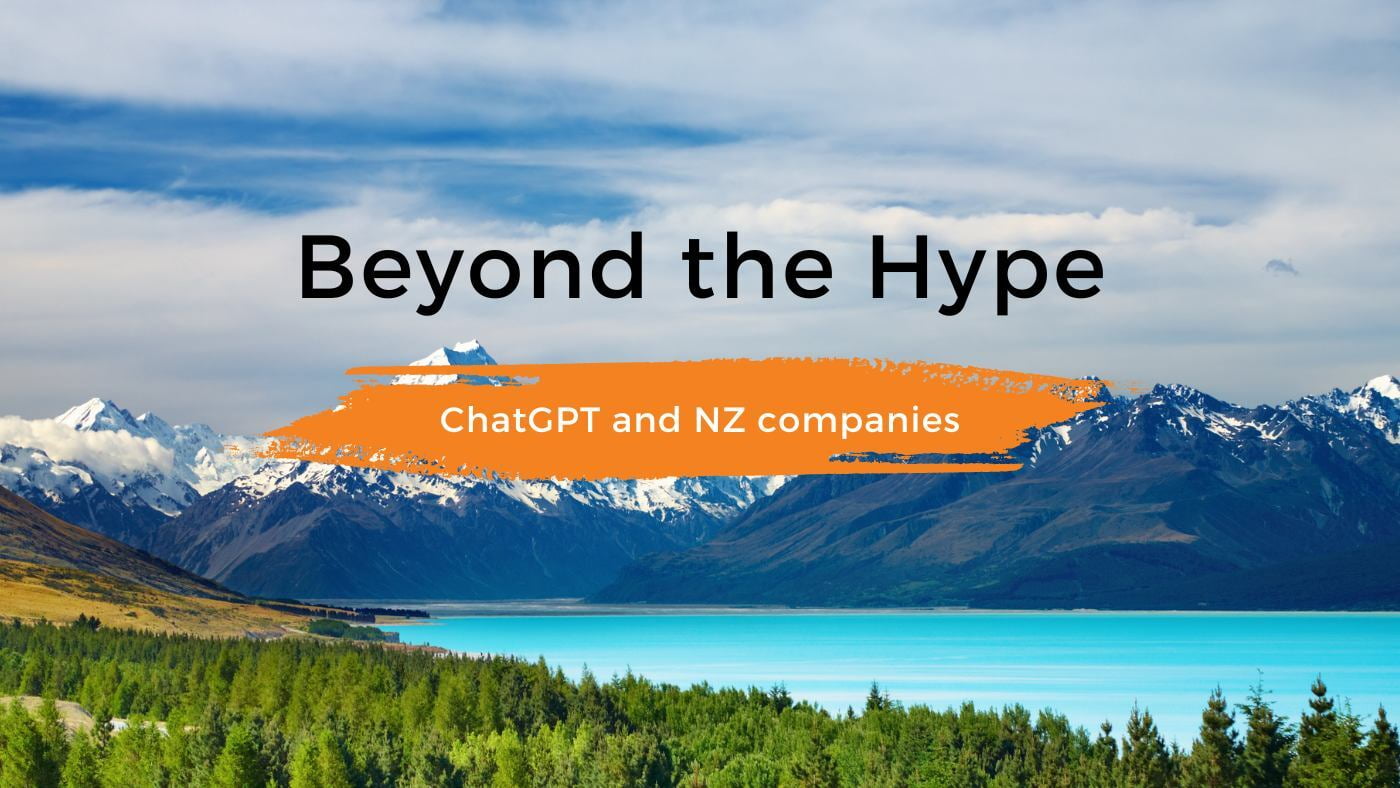by Paul Matthews, CEO
OpenAI’s ChatGPT platform became one of the fastest-growing emerging technologies when it amassed 100 million users in its first two months of public availability.

Write this entire blog please, ChatGPT
I’d wager that tens of thousands of those users are posing their own questions to ChatGPT from here in Aotearoa, including people at businesses large and small that are exploring the potential for generative AI to be deployed in their own operations.
The history of emerging technologies like the internet, smartphones, and cloud computing, shows that the early adopters are able to apply the technology to achieve a competitive advantage.
That can lead to increased market share, improved productivity and even open up new business opportunities. It will be no different with ChatGPT, which as the flagbearer of the generative AI revolution, stands to be as impactful as those other technologies mentioned above.
Productivity boost
The question is how generative AI, based on large language models pioneered by the likes of OpenAI and Google’s DeepMind division, can shift the needle in key areas that can improve our economy’s notoriously poor productivity.
New Zealand businesses have been deploying AI for years, especially as they’ve moved to public cloud platforms and taken advantage of AI and data analytics tools available from the likes of Azure, AWS and Google Cloud.
But generative AI is so new that most organisations are in the discovery phase, experimenting with the technology to test its potential while proceeding cautiously as they consider the data privacy, security and ethical questions the technology raises.

What can NZ businesses do?
From our discussions with clients and partners around the country, here are five ways Kiwi companies are dipping their toes into the world of generative AI:
1. Reinventing customer service:
Many local companies are using GPT-3.5 (Generative Pre-trained Transformer 3), the underlying platform powering ChatGPT, to power customer service chatbots. This service, available via an API (application programming interface) allows them to draw on the pre-trained model that OpenAI has created and which they can buy access to, while informing chat responses with specific information from customer data records.
Companies report significantly better interactions with customers and more natural conversations as a result of employing GPT-3.5 (and its successor GPT-4) compared to the previous generation of chatbots. OpenAI claims the latest version is more creative and better at problem solving. It is also “multimodal” meaning it can analyse the contents of an image and connect that with a written question.
GPT-4 via the API isn’t universally available yet, with OpenAI prioritising companies that can contribute model evaluations to improve the system. The ChatGPT version employing GPT-4 also requires a subscription.
Auckland start-up Soul Machines released Suki in March 2023, its first “GPT-integrated digital influencer”. The digital assistant doesn’t rely on text prompts - you simply talk to Suki and she’ll draw on GPT-3 to give you a useful answer. Suki really advances Soul Machine’s efforts to facilitate life-like interactions with digital assistants. And guess what? Their next gen built on GPT-4, Nova, just came out this week.
They’ve really outdone themselves!

2. Leveraging Microsoft:
Most New Zealand businesses have some sort of relationship with Microsoft, if not for Azure cloud hosting, certainly for access to its suite of products like Microsoft 365, Sharepoint and Dynamics.
As an investor in OpenAI and its exclusive cloud partner, Microsoft is moving rapidly to integrate GPT into its product range, and New Zealand companies are among those being granted early access. The Azure OpenAI Service became available in preview mode last month and lets customers apply GPT-4 and the Dall-E 2 AI image generator to their own enterprise data for knowledge retrieval.
Software developers are already using Microsoft’s AI-powered Github Copilot to boost their productivity. Microsoft claims that 77% of surveyed users found that Copilot helps them “spend less time searching for information and examples”. Copilot is also being rolled out to the Microsoft 365 suite, including Word, Excel, Powerpoint and Teams, which will let users use text prompts to generate text and images within documents, slide decks and presentations.
That’s incredibly powerful capability that will soon be widely available to every Microsoft Office user.

3. Content generation:
ChatGPT’s sweet spot is natural language processing, which makes it particularly good at generating passages of well-written, informative text, drawing on the vast trove of data GPT-4 has been trained on. That’s why students are using it to write their exam papers and creative types are perturbed at the remarkable poems and song lyrics the chatbot can produce when skillfully prompted.
Although it’s not quite at “human-level” creativeness yet and can be repetitive, it’s a darn good start.
Every business needs to generate content, either for marketing/advertising and stakeholder engagement or for internal communications and documentation. Creating compelling documents, whitepapers, blog posts and technical manuals isn’t core business for many organisations.
They struggle to do it well.
ChatGPT excels at helping map out content outlines and quickly populating articles. As more organisations apply GPT-3.5 and GPT-4 to their own databases of information, it will become a core knowledge organising tool for generating articles and reports.

4. Enterprise insights:
This is arguably where the biggest potential in generative AI lies -using the power of these models to make sense of the data your business generates. It could be survey responses from customers or monthly invoices from suppliers. GPT-3.5 is already being used locally to rapidly generate reports based on proprietary information.
A great deal of work is required to optimise internal databases and knowledge repositories to make the most of GPT capabilities. But doing so makes the technology infinitely more useful by allowing it to know the context of activity within your business.
OpenAI doesn’t use data submitted by customers via the API to train its models - unless the customer specifically opts into sharing its data. That’s important for organisations wanting to apply sensitive data to the generative AI platform. But data will still be sent to OpenAI’s servers via an encrypted connection, so data governance policies need to take that into account.
For non-API data, OpenAI, such as ChatGPT and its image-generating sibling DALL-E, the company says it “may use the data you provide us to improve our models”, which may make it unsuitable for feeding proprietary company information into.

5. The new way to search:
If you’ve used the GPT-4 powered Bing Chat feature in Microsoft’s search engine or Bard, which is Google’s equivalent, you’ll have seen how they are changing the nature of internet search engine queries. Rather than entering a word or phrase and receiving a collection of links to visit, Bing and Bard will draw on disparate search results to answer your question, talking you through a topic.
That’s a game changer for how people search for information on the web. As such, any company with a significant digital presence needs to figure out how to optimise their web content for conversational search. Those who put in early effort understanding these platforms are going to have a major advantage when they become the default way to use search engines.
Paul Matthews is Chief Executive of CIO Studio. Thinking about how to leverage AI in your own business? CIO Studio can help. Contact CIO Studio to talk to one of our consultants about laying the foundations to take advantage of platforms like ChatGPT and GPT-3.


